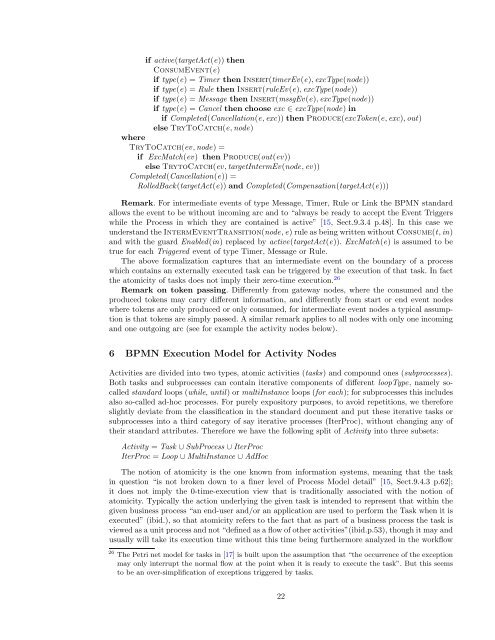BPMN and Beyond Business process modelling notation, workflow ...
BPMN and Beyond Business process modelling notation, workflow ...
BPMN and Beyond Business process modelling notation, workflow ...
You also want an ePaper? Increase the reach of your titles
YUMPU automatically turns print PDFs into web optimized ePapers that Google loves.
if active(targetAct(e)) then<br />
ConsumEvent(e)<br />
if type(e) = Timer then Insert(timerEv(e), excType(node))<br />
if type(e) = Rule then Insert(ruleEv(e), excType(node))<br />
if type(e) = Message then Insert(mssgEv(e), excType(node))<br />
if type(e) = Cancel then choose exc ∈ excType(node) in<br />
if Completed(Cancellation(e, exc)) then Produce(excToken(e, exc), out)<br />
else TryToCatch(e, node)<br />
where<br />
TryToCatch(ev, node) =<br />
if ExcMatch(ev) then Produce(out(ev))<br />
else TrytoCatch(ev, targetIntermEv(node, ev))<br />
Completed(Cancellation(e)) =<br />
RolledBack(targetAct(e)) <strong>and</strong> Completed(Compensation(targetAct(e)))<br />
Remark. For intermediate events of type Message, Timer, Rule or Link the <strong>BPMN</strong> st<strong>and</strong>ard<br />
allows the event to be without incoming arc <strong>and</strong> to “always be ready to accept the Event Triggers<br />
while the Process in which they are contained is active” [15, Sect.9.3.4 p.48]. In this case we<br />
underst<strong>and</strong> the IntermEventTransition(node, e) rule as being written without Consume(t, in)<br />
<strong>and</strong> with the guard Enabled(in) replaced by active(targetAct(e)). ExcMatch(e) is assumed to be<br />
true for each Triggered event of type Timer, Message or Rule.<br />
The above formalization captures that an intermediate event on the boundary of a <strong>process</strong><br />
which contains an externally executed task can be triggered by the execution of that task. In fact<br />
the atomicity of tasks does not imply their zero-time execution. 26<br />
Remark on token passing. Differently from gateway nodes, where the consumed <strong>and</strong> the<br />
produced tokens may carry different information, <strong>and</strong> differently from start or end event nodes<br />
where tokens are only produced or only consumed, for intermediate event nodes a typical assumption<br />
is that tokens are simply passed. A similar remark applies to all nodes with only one incoming<br />
<strong>and</strong> one outgoing arc (see for example the activity nodes below).<br />
6 <strong>BPMN</strong> Execution Model for Activity Nodes<br />
Activities are divided into two types, atomic activities (tasks) <strong>and</strong> compound ones (sub<strong>process</strong>es).<br />
Both tasks <strong>and</strong> sub<strong>process</strong>es can contain iterative components of different loopType, namely socalled<br />
st<strong>and</strong>ard loops (while, until) or multiInstance loops (for each); for sub<strong>process</strong>es this includes<br />
also so-called ad-hoc <strong>process</strong>es. For purely expository purposes, to avoid repetitions, we therefore<br />
slightly deviate from the classification in the st<strong>and</strong>ard document <strong>and</strong> put these iterative tasks or<br />
sub<strong>process</strong>es into a third category of say iterative <strong>process</strong>es (IterProc), without changing any of<br />
their st<strong>and</strong>ard attributes. Therefore we have the following split of Activity into three subsets:<br />
Activity = Task ∪ SubProcess ∪ IterProc<br />
IterProc = Loop ∪ MultiInstance ∪ AdHoc<br />
The notion of atomicity is the one known from information systems, meaning that the task<br />
in question “is not broken down to a finer level of Process Model detail” [15, Sect.9.4.3 p.62];<br />
it does not imply the 0-time-execution view that is traditionally associated with the notion of<br />
atomicity. Typically the action underlying the given task is intended to represent that within the<br />
given business <strong>process</strong> “an end-user <strong>and</strong>/or an application are used to perform the Task when it is<br />
executed” (ibid.), so that atomicity refers to the fact that as part of a business <strong>process</strong> the task is<br />
viewed as a unit <strong>process</strong> <strong>and</strong> not “defined as a flow of other activities”(ibid.p.53), though it may <strong>and</strong><br />
usually will take its execution time without this time being furthermore analyzed in the <strong>workflow</strong><br />
26 The Petri net model for tasks in [17] is built upon the assumption that “the occurrence of the exception<br />
may only interrupt the normal flow at the point when it is ready to execute the task”. But this seems<br />
to be an over-simplification of exceptions triggered by tasks.<br />
22
















